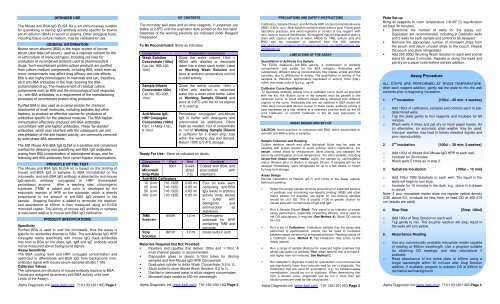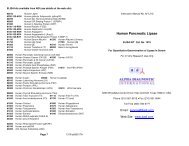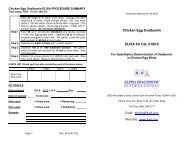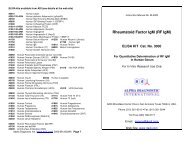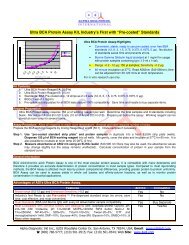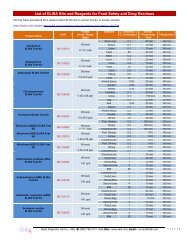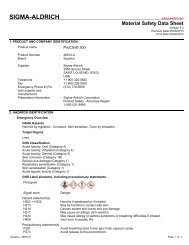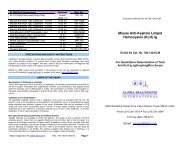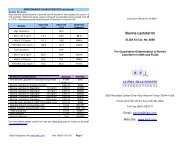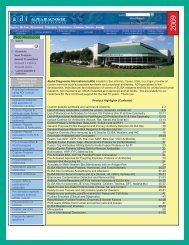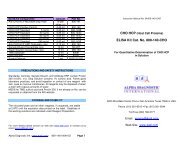Assay Procedure
Assay Procedure
Assay Procedure
Create successful ePaper yourself
Turn your PDF publications into a flip-book with our unique Google optimized e-Paper software.
INTENDED USEThe Mouse anti-BSA IgG ELISA Kit is an immunoassay suitablefor quantifying or titering IgG antibody activity specific for bovineserum albumin (BSA) in serum or plasma. Other biological fluids,including tissue culture medium, may be validated for use.GENERAL INFORMATION ! " ! # !$ % !&'( ')*+' ') #PRINCIPLE OF THE TESTThe Mouse anti-BSA IgG ELISA kit is based on the binding ofmouse anti-BSA IgG in samples to BSA immobilized on themicrowells, and anti-BSA IgG antibody is detected by anti-mouseIgG-specific antibody conjugated to HRP (horseradishperoxidase) enzyme. After a washing step, chromogenicsubstrate (TMB) is added and color is developed by theenzymatic reaction of HRP on the substrate, which is directlyproportional to the amount of anti-BSA IgG present in thesample. Stopping Solution is added to terminate the reaction,and absorbance at 450nm is then measured using an ELISAmicrowell reader. The activity of mouse IgG antibody in samplesis calculated relative to mouse anti-BSA IgG calibrators.PRODUCT SPECIFICATIONSSpecificityPurified BSA is used to coat the microwells; thus the assay isspecific for antibodies directed to BSA. The anti-Mouse IgG HRPconjugate reacts specifically with mouse IgG class antibodiesthat bind to BSA on the plate. IgA, IgM and IgE antibody wouldnot be measured above background signals.<strong>Assay</strong> SensitivityThe BSA coating level and HRP conjugate concentration andoptimized to differentiate anti-BSA IgG from background (nonantibody)signal with mouse serum samples diluted 1:100.Calibrator ValuesThe calibrators are dilutions of mouse antibody reactive to BSA.Values are assigned as arbitrary anti-BSA activity units (seeLimits of the <strong>Assay</strong>).Alpha Diagnostic Intl (www.4adi.com) 710-130/120116G Page 1KIT CONTENTSThe microtiter well plate and all other reagents, if unopened, arestable at 2-8 o C until the expiration date printed on the box label.Stabilities of the working solutions are indicated under ReagentPreparation.To Be Reconstituted: Store as indicated.ComponentWash SolutionConcentrate (100x)Cat. No. WB-100,10mlSample DiluentConcentrate (20x)Cat. No. SD-20B,10mlAnti-Mouse IgG-HRP ConjugateConcentrate (100x)Part: H-MsG-112c,0.15mlPreparation InstructionsDilute the entire volume 10ml +990ml with distilled or deionizedwater into a clean stock bottle. Labelas Working Wash Solution andstore at ambient temperature until kitis used entirely.Dilute the entire volume, 10ml +190ml with distilled or deionizedwater into a clean stock bottle. Labelas Working Sample Diluent andstore at 2-8 o C until the kit lot expiresor is used up.Peroxidase conjugated anti-MouseIgG in buffer with detergents andantimicrobial as stabilizers. Dilutefresh as needed; 10ul of concentrateto 1ml of Working Sample Diluentis sufficient for 1 8-well strip. Usewithin the working day and discard.Return 100X to 2-8 o C storage.Ready For Use: Store as indicated on labels.Component Part Amt ContentsBSA8001 8-well Coated with BSA, andMicrowellstrips post-coated withStrip Plate(12) stabilizers.Anti-BSA Calibrators10 U/ml25 U/ml50 U/ml100 U/ml710-132B710-132C710-132D710-132E0.65 ml0.65 ml0.65 ml0.65 mlFour (4) vials, eachcontaining anti-BSAIgG levels in arbitraryactivity Units; dilutedin buffer withdetergents andantimicrobial asstabilizers.TMBSubstrateStopSolution80091 12 ml Chromogenicsubstrate for HRPcontaining TMB andperoxide.80101 12 ml Dilute sulfuric acid.Materials Required But Not Provided: Pipettors and pipettes that deliver 100ul and 1-10ml. Amulti-channel pipettor is recommended. Disposable glass or plastic 5-15ml tubes for dilutingsamples and Anti-Mouse IgG HRP Concentrate. Graduated cylinder to dilute Wash Concentrate; 0.2 to 1L. Stock bottle to store diluted Wash Solution; 0.2 to 1L. Distilled or deionized water to dilute reagent concentrates. Microwell plate reader at 450 nm wavelength.Alpha Diagnostic Intl (www.4adi.com) 710-130/120116G Page 2PRECAUTIONS AND SAFETY INSTRUCTIONSCalibrators, Sample Diluent, and Antibody HRP contain bromonitrodioxane(BND: 0.05%, w/v). Stop Solution contains dilute sulfuric acid. Follow goodlaboratory practices, and avoid ingestion or contact of any reagent withskin, eyes or mucous membranes. All reagents may be disposed of down adrain with copious amounts of water. MSDS for TMB, sulfuric acid andBND can be requested or obtained from the ADI website:http://4adi.com/commerce/info/showpage.jsp?page_id=1060&category_id=2430&visit=10LIMITATIONS OF THE ASSAYQuantitation of Antibody in a SampleThe ELISA measures anti-BSA activity, a combination of antibodyconcentration and avidity for the BSA antigens. Antibodies withsubstantially different total Ig concentrations may display similar anti-BSAactivities, due to differences in avidity. The quantitation or activity of thesamples is, therefore, appropriately expressed in activity Units (titer),rather than mass units of Ig (e.g., ug/ml).Calibrator Curve QuantitationTo quantitate antibody activity from a calibrator curve (such as providedwith the kit), the dilution curve of the samples must be parallel to thecalibrator curve, to avoid different values being obtained from differentregions of the curve. Antibodies that are not matched in BSA avidity willoften have non-parallel dilution curves. In these cases, antibody activity isbest expressed as a titer relative to a reference positive such as the 25U/ml Calibrator, or another Calibrator in the kit (see Calculation ofResults).ASSAY DESIGN AND SET-UPCAUTION: Avoid solutions or containers with BSA, which would block ordiminish anti-BSA activity in samples.Sample Collection and HandlingCulture medium, serum and other biological fluids may be used assamples with proper dilution to avoid solution matrix interference. Forserum, collect blood by venipuncture, allow clotting, and separate theserum by centrifugation at room temperature. For other samples, includingserum-free tissue culture media, clarify the sample by centrifugationand/or filtration prior to dilution in Sample Diluent. If samples will not beassayed immediately, store refrigerated for up to a few weeks, or frozenfor long-term storage.<strong>Assay</strong> DesignReview Calculation of Results (p5-7) and Limits of the <strong>Assay</strong> (above)before proceeding:Select the proper sample dilutions accounting for expected potencyof positives and minimizing non-specific binding (NSB) and othermatrix effects; for example, net signal for non-immune samplesshould be
INTERPRETATION OF RESULTSCALCULATION OF RESULTS (continued)CALCULATION OF RESULTS (continued)Calculation of ResultsConsider several data reduction methods to best represent therelationships among experimental and control groups, todetermine Positive Immune and Negative Non-immune, and toQuantitate positive antibody levels.Method A. Antibody Activity [ELISA Signal & Sample Dilution]Represent data as net OD units (A450 signal; blank subtracted)÷ dilution = Total Activity Units.A Calibrator value in the mid-OD range (e.g., 25 U/ml) can beused to normalize inter-assay values.Method B. Positive IndexExperimental sample values may be expressed relative to thevalues of Control or Non-immune samples, by calculation of aPositive Index. One typical method is as follows:1. Calculate the net OD mean + 2 SD of theControl/Non-immune samples = Positive Index.2. Divide each sample net OD by the Positive Index.Values above 1.0 are a measure of PositiveAntibody Activity; below 1.0 are Negative forantibody.A sample value would be Positive if significantly above the valueof the pre-immune serum sample or a suitably determined nonimmunepanel or pool of samples, tested at the same sampledilution. This calculation quantifies the positive Antibody Activitylevel.Example:<strong>Assay</strong>Net ODCalculatedAntibody ActivitySample Control Exptl Control ExptlMethod C. Use of a Calibrator CurveWhen the dilution curves of samples are parallel to the Calibratorcurve (see Limits of the <strong>Assay</strong>), the anti-BSA activity units maybe determined by interpolation from the Calibrator curve. Theresults may be calculated using any immunoassay softwarepackage. If software is not available, anti-BSA activityconcentrations may be determined as follows:1. Calculate the mean OD of duplicate samples.2. On graph paper plot the mean OD of the calibrators (y-axis)against the concentration (U/ml) of anti-BSA (x-axis). Drawthe best fit curve through these points to construct thecalibrator curve. A point-to-point construction is mostcommon and reliable.3. The anti-BSA activity concentrations in unknown samplesand controls can be determined by interpolation from thecalibrator curve.4. Multiply the values obtained for the samples by the dilutionfactor of each sample.5. Samples producing signals higher than the 100 U/mlcalibrator should be further diluted and re-assayed.Typical Results:Wells Calibrators A450 nmA1,2 Negative Diluent Blank 0.16B1,2 10 U/ml Calibrator 0.50C1,2 25 U/ml Calibrator 0.96D1,2 50 U/ml Calibrator 1.58E1,2 100 U/ml Calibrator 2.21F1,2 Sample 1:100 1.21Sample Result: 33 U/ml x 100 dilution = 330 U/mlMethod D. Titers from Sample Dilution CurvesThe titer of antibody activity calculated from a dilution curve ofeach sample is recommended as the most accurate quantitativemethod. Best precision can be obtained using the followingguidelines:1. Use an OD value Index in the mid-range of the assay (2.0 –0.5 OD); this provides the best sensitivity andreproducibility for comparing experimental groups andreplicates. An arbitrary 1.0 OD is commonly used.2. Prepare serial dilutions of each sample to provide a seriesthat will produce signals higher and lower than the selectedindex. With accurate diluting, duplicates may not berequired if at least 4 dilutions are run per sample.3. A 5-fold dilution scheme is useful to efficiently cover a widerange which produces ODs both above and below 1.0 OD.The dilution scheme can be tightened to 3-fold or 2-fold formore precise comparative data.4. A Calibrator value in the mid-OD range (e.g., 25 U/ml) canbe used to normalize inter-assay values.Calculations1. On a log scale of inverse of Sample Dilution as the x-axis,plot the OD values of the two dilutions of each positivesample having ODs above and below the OD value of theIndex (arbitrary or selected Calibrator).2. From a point-to-point line drawn between the two sampleODs, read the dilution value (x-axis) corresponding to theOD of the selected Index= Total IgG Antibody Activity UnitsExample:II. A 1.0 OD Index was used to determine titer of 4 antibodies.32.52Sample ASample BSample CSample DInstruction Manual No. M-710-130-BSMMouse Anti-Bovine SerumAlbumin (BSA) IgGELISA Kit Cat. No. 710-130-BSMFor Quantitation of anti-BSAIgG in Serum6203 Woodlake Center Drive • San Antonio• Texas 78244 • USA.Phone (210) 561-9515 • Fax (210) 561-9544Toll Free (800) 786-5777Email: service@4adi.com1 0.243 2.358 0.49 4.792 0.351 0.597 0.71 1.213 0.286 1.421 0.58 2.894 0.357 1.268 0.73 2.585 0.512 0.857 1.04 1.746 0.342 1.296 0.70 2.637 0.298 0.608 0.61 1.248 0.285 0.369 0.58 0.759 0.157 0.864 0.32 1.7610 0.187 0.543 0.38 1.10Mean 0.302SD 0.095Mean+2 SD 0.492 = Positive IndexA4502.521.510.5010 100Mouse Anti-BSA, U/ml1.510.501 3 9 271/dilution x 1kTiter ValuesSample A = 1.72 kUSample B = 5.70 kUSample C = 1.85 kUSample D = 7.90 kUELISA Kit Components AmountPartBSA Coated Microwell Strip Plate 8-well strips 8001(12)Mouse Anti-BSA IgG Calibrator 10 U/ml 0.65 ml 710-132BMouse Anti-BSA IgG Calibrator 25 U/ml 0.65 ml 710-132CMouse Anti-BSA IgG Calibrator 50 U/ml 0.65 ml 710-132DMouse Anti-BSA IgG Calibrator 100 U/ml 0.65 ml 710-132EAnti-Mouse IgG HRP Conjugate (100X) 0.15 ml H-MsG-112cSample Diluent (20x) 10 ml SD20BWash Solution Concentrate (100X) 10 ml WB-100TMB Substrate 12 ml 80091Stop Solution 12 ml 80101Product Manual 1 ea M-710-130-BSMAlpha Diagnostic Intl (www.4adi.com) 710-130/120116G Page 5Alpha Diagnostic Intl (www.4adi.com) 710-130/120116G Page 6Alpha Diagnostic Intl (www.4adi.com) 710-130/120116G Page 7


